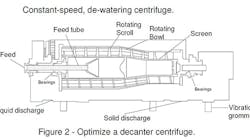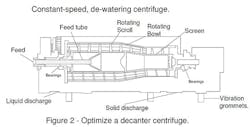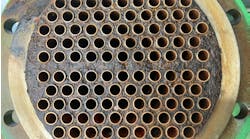This Month’s Puzzler
Our 25-year-old vacuum scrubber system (figure online) had worked flawless for two years; now, it’s responsible for a toxic release. We increased the vent volume about 20% last year. At the time, the safety and environmental engineer complained bitterly that the capacity already was overtaxed, noting that we had added more demand over the years and the material balance wasn’t well understood. Still, the system worked fine, although operators complained of fumes.
Our maintenance manager looked at the equipment and found the following:
• The blower has been rebuilt several times; its capacity was increased once, five years ago.
• The pH probes were abandoned — the system is on the roof and the probes fouled often — and replaced by a titrator; the lab services the titrator because maintenance and operations forgot to keep up on reagents.
• The dike floor has cracked and heaved; equipment additions mean the dike now is slightly undersized (58,000-gal required versus 56,000-gal available).
• The mist eliminator was eliminated years ago because maintenance was annoyed by its fouling.
The project group says it will cost a fortune to replace the system and repair the secondary containment because this system is integral to plant operations. In addition, there’s a dispute over containment volume: operations say we should count the blower containment, which is elevated above the scrubber area and drains into it but the safety engineer disagrees. The project group proposes putting a roof over the area to eliminate stormwater concerns. The maintenance engineer says that’s impossible because the diluted caustic in the mixing shack is cooled by an airfoil cooler.
How should we proceed with this project? Do you see any other concerns?
First Maintain Compliance
Air permitting issues should be addressed promptly. In this case, the plant should notify the regulatory agency and get approval for a temporary system (say, a skid) to retain compliance with the air permit.
As the problem statement indicates, even after increasing gas flow by 20%, the scrubber system was able to attain compliance with the plant’s air permit. It is possible that a sudden change in flow could have damaged or displaced column internals. This, in turn, would lead to flow maldistributions. You should review trend charts or the historian to identify if there were abrupt changes in flows, temperatures and other relevant variables.
Check vapor compositions to determine if vapors contain higher concentrations of the species regulated by the air permit.
Examine concentrations, flow rates and temperatures of caustic. On a temporary basis, consider increasing caustic concentration to see if this helps you remove the pollutant in the vapor stream. Of course, higher concentration could lead to potential plugging problems in packing and the mist eliminator. Higher concentration also could result in a greater amount of heat in the scrubber. If this does work without additional problems, try using caustic at a higher concentration.
What was the reason (or reasons) why the blower had to be re-built several times? Check past records to see which components failed. You may need to upgrade components that fail frequently. In addition, because operators have complained about fumes (which the problem statement suggests are a nuisance rather than a health hazard), reroute the blower outlet to a more suitable location — away from work area.
Consider re-installing the mist eliminator — its absence could have caused the fumes. To minimize plugging, install a water spray to back-wash the mist eliminator. You can activate water spray based on pressure drop across the mist eliminator, say, 0.2–0.3-in. water. (Check with the vendor.) Or you can spray at certain time intervals.
The problem statement indicates the dike is in severe disrepair; this could lead to groundwater contamination and, hence, to permit issues. Inadequate dike size also results in non-compliance with industry standards (e.g., NFPA), which, in turn, could affect insurance coverage.
As an overall observation, although the project group has expressed concern over costs (and their concern should be respected), environmental infractions and safety issues could result in consequences that could pose an existential threat to your plant.
GC Shah, senior consultant
Wood Group, Houston
Check The Material Balance
“Worked flawlessly for two years?” What about the previous 25 years? Record-keeping for such utility systems is notoriously poor. Your best bet is to talk to operators, retired or active. Focus particularly on new equipment as a sign that something was wrong with the old equipment. Ask maintenance when the mist eliminator was removed. More than likely with such a system, fumes are coming from the sources, not the tower itself.
As chemical engineers should realize, it’s best to start with the material balance. Even if all the information is available — physical properties, flowrates and stream characteristics (temperature, pressure, etc.) — chances are you’ll find grounds for questioning it. Take samples of the scrubber sump, caustic, wastewater and vapor stream (if possible). Confirm even accepted values like density and viscosity. In other words, start fresh.
Vapor flows are challenging but can be estimated using a ruler and a hand-held anemometer to measure gas velocity; expect to need a lot of practice to get it right. You’ll be looking at pickup velocities for the sources going to the scrubber. As for vapor physical properties, it’s customary to assume a perfect gas mixture for air: ρ = PM/RT, where ρ= density and M = 28.964. If you want to be fancy, use psychrometry to estimate water vapor.
For the liquid flows, use the spray nozzles as a check against pump calculations. Carefully look at the spray nozzle pressure drop: atomized flow takes away from liquid wetting the packing. The spray nozzle manufacturer can tell what the best range is for your spray nozzles; usually about 7 psi is desirable.
Of course, a fresh look at the stream properties may reveal unconsidered issues. For example, solids or scaling factors, like calcium carbonate, in the wastewater could be a reason why the scrubber isn’t performing well. Also, don’t assume that raw materials like caustic are pure. Assess minor constituents in a stream.
So, what can you do to achieve some immediate improvements without increasing costs? Start by reducing tramp air at the hood. Shut off or cut back the flow of gas to the scrubber by using available dampers. Increase the flow of the pump. Raise the concentration of the caustic slightly.
If you do have some capital funds, consider: adding the mesh pad; installing additional dampers to isolate unused sources; improving pickup points at sources by replacing worn seals and extending them; and increasing the size of the pump impeller and spray nozzle to raise the liquid flow and the KGa for mass transfer.
The next level of investment would be to replace the blower with a larger one and perhaps split the gas flow to a second, new scrubber. Don’t forget the electrical when considering a larger blower: running larger motor cables will be expensive and could overtax the plant electrical grid.
Automatic titration systems are problematic at best because the pumping system is separate from the titration system. At least with manual sampling, the operators won’t ignore the scrubber — provided there’s some oversight of the lab results.
Roofs do reduce stormwater accumulation but that’s not most of the containment volume. It’s probably not worth the trouble. Fixing the concrete is important but flow to a waterway depends a lot on soil conditions. You might be able to delay a decision if you can contain the seepage or if the soil is a hard clay.
The dike floor probably cracked because it wasn’t installed correctly. If you get only 20–30 years out of concrete, it means the civil engineer blew it. Most engineers don’t understand how containment works: the floor “floats” on the ground. If the ground collects water or is unstable, the dike floor will heave and crack. A French drain and a sump pump are required to pull the water away. Unfortunately, once the concrete is poured and equipment and tank pads are added, it’s difficult to replace the concrete — especially if flammable liquids are nearby. Such cases require use of hand tools, increasing the cost of the demolition and repairs by a factor of about four. Your best bet may be to rebuild correctly somewhere else and demo the site at your leisure rather than shutting down the plant for a month or more for repairs.
Another option might be to install a double-walled tank and rebuild the dike for the pump exclusively. Double-walled tanks don’t need secondary containment.
Dirk Willard, consultant
Wooster, Ohio
Figure 1. A number of problems afflict currently installed units.
February’s Puzzler
Our constant-speed continuous decanter centrifuges (Figure 1) aren’t doing a good job in separating corn starch from water. In truth, these units never have worked well but we could get by because our process has some redundancy. Now, due to a six-sigma initiative, I’ve been asked to optimize centrifuge operations. My investigation has found a variety of problems, including: variations in feed-stream concentration — the flow rate changes only slightly; bearing failure because crystals get past the shaft seals — we added a hot-water/steam flush of the scroll to eliminate this problem but we now get scroll vibration; some corrosion attack is starting at welds where the stainless steel has gone to rust — this mainly appears on the outside of the feed tube but we also see attacks in the screen and, now, even the scroll; seal failure has become a monthly affair because of shaft corrosion; a likely increase in the risk of fire from solid buildup behind the seals; and surging at the solids discharge lip and swamping at the water discharge.
Maintenance is pushing to replace the centrifuges because they cost $2.2 million/year to maintain. Projects says swapping them with new dual-drive or hydraulically driven centrifuges to handle the variations in solids loading and flowrate would eliminate this cost. However, an electrician brought in to assess the over-taxing of the electrical system warns these new drives would affect the starting and stopping loads on our grid. Operations prefers the existing setup because of its familiarity.
What do you think? Are these units worth saving? Is there anything else we should consider?
Send us your comments, suggestions or solutions for this question by January 10, 2020. We’ll include as many of them as possible in the February 2020 issue and all on ChemicalProcessing.com. Send visuals — a sketch is fine. E-mail us at [email protected] or mail to Process Puzzler, Chemical Processing, 1501 E. Woodfield Rd., Suite 400N, Schaumburg, IL 60173. Fax: (630) 467-1120. Please include your name, title, location and company affiliation in the response.
And, of course, if you have a process problem you’d like to pose to our readers, send it along and we’ll be pleased to consider it for publication.



